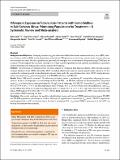| dc.description.abstract | Background and Objectives
Emerging evidence suggests that comorbidities like human immunodeficiency virus (HIV) infection, diabetes mellitus (DM), and malnutrition in tuberculosis (TB) patients can alter drug concentrations, thereby affecting the treatment outcomes. For these populations, personalised strategies such as therapeutic drug monitoring (TDM) may be essential. We investigated the variations of drug levels within comorbid populations and analysed the differences in patterns observed between sub-Saharan Africa (SSA) and non-SSA regions.
Methods
We performed a systematic review and meta-analysis of rifampicin drug pharmacokinetics (PK) through searches of major databases from 1980 to December 2023. A random-effects meta-analysis model using R-studio version 4.3.2 was conducted to estimate pooled serum rifampicin exposure (area under the concentration-time curve [AUC], and peak maximum concentration [Cmax]) between patients with TB-HIV infection, and TB-DM.
Results
From 3300 articles screened, 24 studies met inclusion criteria, contributing 33 comorbidity subgroups for meta-analysis. In SSA, 14 subgroups assessed rifampicin PK in TB-HIV, 1 in TB-DM, and none in TB-malnutrition. The pooled mean Cmax was below the recommended range (8–24 mg/L) for all subgroups. For TB-HIV, the pooled Cmax was 5.59 mg/L, 95% CI (4.59–6.59), I2 = 97% for SSA populations and 5.59 mg/L, 95% CI (3.65; 6.59) for non-SSA populations. The Cmax for TB-DM in SSA (9.60 ± 4.4 mg/L) exceeded non-SSA (4.27 mg/L, 95% CI [2.77–5.76]). The lowest AUC was in TB-HIV (SSA, 29.09 mg/L h, 95% CI [21.06; 37.13, I2 = 91%]). High variability and heterogeneity (I2 >90%) were observed, with most studies (20/23) showing low bias.
Conclusion
Our results emphasise the need for individualised dosing and targeted TDM implementation among TB-HIV and TB-DM populations on rifampicin in SSA. Although all populations exhibited low Cmax levels, TB-HIV populations may be prioritised as AUC levels were lowest. In clinical settings in SSA, Cmax-based TDM is more practical, but AUC can be used in treatment where feasible. | en_US |

